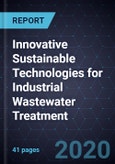Advancements in Membrane Separation, Oxidation Processes and Micro-Bubble Generators to Enhance the Sustainability of Industrial Wastewater Treatment
According to the United Nations, the global population is estimated to reach 8.1 billion in 2025 and the subsequent economic growth to cater to the demands of this growing population will push the stress levels of the water resources to the extreme limit. The US Intelligence Community Assessment of Global Water Security has also predicted that the global water requirements will exceed the sustainable water supplies by 20-30 % by 2025. Thus the depletion of water resources could become the main limiting factor for the expansion of industrial corridors and special economic zones. Additionally, technological challenges to efficiently treat the pollutants from the industrial effluents, and the costs associated with the industrial wastewater treatment limit the adoption of the conventional wastewater technologies which can have a negative impact on human health and environment.
It is, therefore, necessary to treat industrial wastewater sustainably in order to adhere to the Zero Liquid Discharge guidelines or to enable the effective reuse of treated effluents. It is also important to make use of sustainable industrial wastewater treatment technologies that can be easily retrofitted into the existing wastewater treatment plants. The use of such technologies enables the stakeholder to reduce indirect water costs and other water-related legal costs. The advent of technological advancements in electrochemical oxidation and membrane processes paves way for an efficient route to treat industrial wastewater in an economical and a sustainable manner.
This research study focuses on:
- Overview of the sustainable industrial wastewater treatment technologies
- Key stakeholders involved in sustainable industrial wastewater treatment
- IP Analysis
- Growth opportunities
Table of Contents
Chapter 1: Strategic Imperatives
1.1 Why Is It Increasingly Difficult to Grow?
1.2 The Strategic Imperative 8™
1.3 The Impact of the Top Three Strategic Imperatives on Industrial Wastewater Treatment
1.4 About The Growth Pipeline Engine™
1.5 Research Methodology
Chapter 2: Executive Summary
2.1 Overview of Industrial Wastewater Treatment Technologies
2.2 Industrial Wastewater Treatment Working Model
2.3 Sustainable Technology - Electrochemical Advanced Oxidation Processes
2.4 Sustainable Technology - Biological Wastewater Treatment
2.5 Sustainable Technology - Hybrid Membrane Technologies
Chapter 3: Companies to Action
3.1 Akvola Technologies
3.1.1 MicroGas™ - Microbubble Generator
3.2 OxyMem Limited
3.2.1 Membrane Aerated Biofilm Reactor
3.3 Mitsubishi Electric Corporation
3.3.1 Gas-liquid Interface Discharge Plasma Technology
3.4 H2O Innovation Inc.
3.4.1 SILO Membrane Bioreactor System
3.5 WEF Institute of Technology Inc.
3.5.1 Metallic Ion Elution Material with ASAL treatment
Chapter 4: IP Landscape
4.1 The US to Demonstrate the Most Number of Patent Publications
4.2 Xyleco, Evoqua, and Toray to Lead Patenting Activities Across the Globe
Chapter 5: Growth Opportunities: Industry Wastewater Treatment
5.1 Growth Opportunity 1: R&D Investment for Technological Innovation, 2020
5.2 Growth Opportunity 2: R&D Partnerships for Thrusting Business Growth, 2020
5.3 Growth Opportunity 3: New Product Development for Sustainable Future, 2020
Key Contacts
Legal Disclaimer
Companies Mentioned (Partial List)
A selection of companies mentioned in this report includes, but is not limited to:
- Akvola Technologies
- H2O Innovation Inc.
- Mitsubishi Electric Corporation
- OxyMem Limited
- WEF Institute of Technology Inc.








